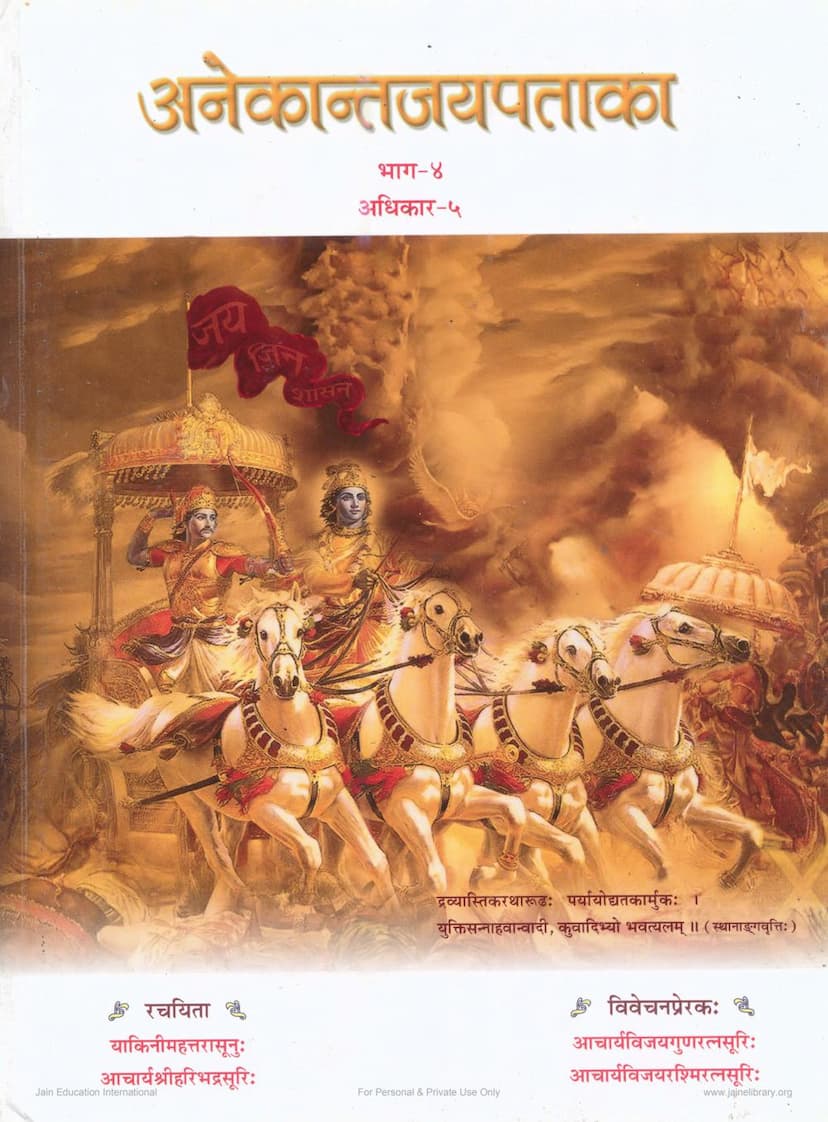Anekantjaipataka Part 04
Added to library: September 1, 2025

Summary
This comprehensive summary is based on the provided Jain text, focusing on the philosophical arguments presented in the fifth chapter ("Bahyarthasiddhi") of the fourth part of "Anekantjaypataka."
Book Title: Anekantjaypataka Part 04 Author(s): Bhavyasundarvijay, Yashratnavijay Publisher: Jingun Aradhak Trust
Overall Summary:
The text "Anekantjaypataka Part 04" is a philosophical treatise that deeply delves into the principles of Jainism, particularly focusing on the concept of Anekantavada (non-one-sidedness or manifold aspects) and the reality of external objects (Bahyartha). This specific part (Part 04, Chapter 05) aims to refute the nihilistic views of certain philosophical schools, primarily the Yogachara school of Buddhism, which deny the existence of external objects. The work ardently establishes the existence and nature of external reality through rigorous logical argumentation and refutation of opposing viewpoints.
Key Philosophical Concepts and Arguments Presented:
-
The Nature of Reality and Anekantavada: The text begins by emphasizing the unparalleled depth and comprehensive nature of the Jinshasan (Jain teachings). It highlights that Anekantavada provides a profound understanding of things, logically establishing concepts like Karma, Ayopasham (the gradual unfolding of karmic potential), and knowledge. It asserts that Anekantavada irrefutably establishes the principles of Sadvada (syadvada) and refutes one-sided viewpoints, including those of Buddhist and Vaisheshika philosophies. It specifically targets and refutes misconceptions like Jnanadvaita (consciousness is the sole reality), Shabdadvaita (sound is the sole reality), and Ekanta (one-sidedness).
-
Refutation of Yogachara Nihilism (Bahyartha Nirakar):
- The Yogachara Argument: The Yogachara school's core tenet is that external objects do not exist; only consciousness is real. They argue that what we perceive as external objects are merely mental constructs or projections. The text systematically presents and then dismantles these arguments.
- Atomism vs. External Objects: The Yogachara position is challenged by analyzing the concept of atoms (paramanu). The text argues that if external objects exist, they must be either atoms, aggregates of atoms, or wholes (avayavi). It systematically refutes the idea that atoms themselves can account for our perception of external objects.
- Critique of Perceptual Arguments: The text refutes the Yogachara claim that atoms are imperceptible to the senses and even to yogis. It argues that the perception of gross objects (sthulaakara) implies the existence of subtle components that, while not directly perceived in isolation, are indirectly known through their manifestations.
- The Problem of Causality: A significant portion of the refutation focuses on the causal relationship between external objects and our perceptions. The text argues that if external objects are denied, then the very notion of causality becomes problematic. How can consciousness alone produce the experience of a determinate external object without any external referent?
- The Self-Luminous Nature of Consciousness: The Yogachara argument often relies on the self-luminosity of consciousness. However, the text counters that this self-luminosity does not negate the existence of an external object; rather, it suggests consciousness's ability to cognize that object.
-
Establishment of External Reality (Bahyartha Siddhi):
- Pratyaksha and Anumana: The text reasserts the validity of both direct perception (pratyaksha) and inference (anumana) in establishing the existence of external objects. It argues that the denial of external reality leads to logical contradictions and an inability to explain everyday experience.
- The Reality of Atoms and Aggregates: The text defends the Jain view of subtle atoms (paramanu) and their aggregation into composite substances (avayavi). It argues that these entities are necessary to explain the perceivable world and that their existence is logically consistent.
- The Nature of Perception: It explains how perception, even when it seems distorted (like seeing two moons), is ultimately based on an interaction with external reality, even if that reality is partially obscured or misinterpreted. The distortion itself points to an external referent that is being misperceived.
- The Role of Causality and Conventional Truth (Vyavahara): The text highlights that while ultimate reality (paramartha) might be complex, conventional reality (vyavahara) and everyday experience strongly support the existence of external objects. It explains how causal processes and the very nature of our interactions with the world point to an external framework.
-
Refutation of Other Philosophical Schools: While primarily engaging with Yogachara, the text also touches upon the refutation of arguments from other schools like Vaisheshika, demonstrating the comprehensive approach of Anekantavada in addressing diverse philosophical challenges.
-
Structure and Content of the Fifth Chapter: The chapter systematically presents the Yogachara arguments against external objects and then meticulously refutes each point with logical reasoning, scriptural references (implicitly, as the text is a commentary on a larger work), and analogies. The structure involves presenting a premise, analyzing its implications, and then showing how it leads to contradictions or logical fallacies.
Key Figures and Commentary:
- The original work is attributed to Acharya Shri Haribhadrasuri, a renowned Jain scholar.
- The current edition's commentary and analysis are inspired by Acharya Vijaygunaratnasuri and Acharya Vijayrashmiratnasuri.
- The research and compilation are by Muniraj Shri Bhavyasundarvijayji M.S., with assistance from Muniraj Shri Saumyaratnavijayji M.S. and Muniraj Shri Tirtharatnavijayji M.S.
- The critical review and editing were done by Muniraj Shri Yashratnavijayji M.S.
In essence, the text is a powerful defense of the Jain perspective on the reality of the external world, presented through a detailed and analytical refutation of opposing philosophical systems. It underscores the validity of Anekantavada as a framework for understanding reality in its multifaceted complexity.